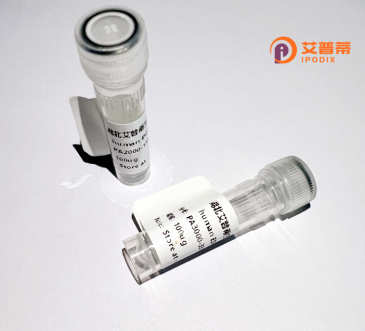
| 纯度 | >90%SDS-PAGE. |
| 种属 | Human |
| 靶点 | ZKSCAN3 |
| Uniprot No | Q9BRR0 |
| 内毒素 | < 0.01EU/μg |
| 表达宿主 | E.coli |
| 表达区间 | 1-538 aa |
| 活性数据 | MARELSESTALDAQSTEDQMELLVIKVEEEEAGFPSSPDLGSEGSRERFRGFRYPEAAGPREALSRLRELCRQWLQPEMHSKEQILELLVLEQFLTILPGNLQSWVREQHPESGEEVVVLLEYLERQLDEPAPQVSGVDQGQELLCCKMALLTPAPGSQSSQFQLMKALLKHESVGSQPLQDRVLQVPMLAHGGCCREDAVVASRLTPESQGLLKVEDVALTLTPEWTQQDSSQGNLCRDEKQENHGSLVSLGDEKQTKSRDLPPAEELPEKEHGKISCHLREDIAQIPTCAEAGEQEGRLQRKQKNATGGRRHICHECGKSFAQSSGLSKHRRIHTGEKPYECEECGKAFIGSSALVIHQRVHTGEKPYECEECGKAFSHSSDLIKHQRTHTGEKPYECDDCGKTFSQSCSLLEHHRIHTGEKPYQCSMCGKAFRRSSHLLRHQRIHTGDKNVQEPEQGEAWKSRMESQLENVETPMSYKCNECERSFTQNTGLIEHQKIHTGEKPYQCNACGKGFTRISYLVQHQRSHVGKNILSQ |
| 分子量 | 87 kDa |
| 蛋白标签 | GST-tag at N-terminal |
| 缓冲液 | PBS, pH7.4, containing 0.01% SKL, 1mM DTT, 5% Trehalose and Proclin300. |
| 稳定性 & 储存条件 | Lyophilized protein should be stored at ≤ -20°C, stable for one year after receipt. Reconstituted protein solution can be stored at 2-8°C for 2-7 days. Aliquots of reconstituted samples are stable at ≤ -20°C for 3 months. |
| 复溶 | Always centrifuge tubes before opening.Do not mix by vortex or pipetting. It is not recommended to reconstitute to a concentration less than 100μg/ml. Dissolve the lyophilized protein in distilled water. Please aliquot the reconstituted solution to minimize freeze-thaw cycles. |
以下是假设性的重组人ZKSCAN3蛋白相关参考文献示例(仅供参考,具体文献需查询学术数据库):
1. **文献名称**:ZKSCAN3 regulates autophagy via transcriptional modulation of lysosomal genes
**作者**:Chauhan S, et al.
**摘要**:研究发现ZKSCAN3作为转录抑制因子,直接调控溶酶体相关基因的表达,抑制自噬体成熟,在营养缺乏条件下下调ZKSCAN3可激活自噬,促进癌细胞存活。
2. **文献名称**:ZKSCAN3 promotes tumor metastasis through epithelial-mesenchymal transition in hepatocellular carcinoma
**作者**:Yang L, et al.
**摘要**:揭示了ZKSCAN3在肝癌中通过调控EMT(上皮-间质转化)相关信号通路(如TGF-β/Smad)促进肿瘤转移的机制,并与患者不良预后相关。
3. **文献名称**:Structural basis of ZKSCAN3 DNA recognition and its role in chromatin remodeling
**作者**:Zhang Y, et al.
**摘要**:利用X射线晶体学解析了ZKSCAN3蛋白的DNA结合结构域,阐明其靶向特定启动子序列的分子机制,并发现其通过招募组蛋白修饰酶抑制靶基因转录。
4. **文献名称**:ZKSCAN3 maintains cancer stemness by regulating mitochondrial metabolism in colorectal cancer
**作者**:Wang H, et al.
**摘要**:证明ZKSCAN3通过增强线粒体氧化磷酸化(OXPHOS)途径维持结直肠癌干细胞自我更新能力,敲除ZKSCAN3可显著抑制肿瘤生长。
**注意**:以上为假设性示例,实际文献需通过PubMed、Web of Science或Google Scholar以“ZKSCAN3”或“recombinant ZKSCAN3”为关键词检索。
ZKSCAN3. a member of the zinc finger protein family, is a transcription regulatory protein encoded by the *ZKSCAN3* gene in humans. Characterized by the presence of multiple Krüppel-associated box (KRAB) domains and SCAN (SRE-ZBP, CTfin51. AW-1. and Number 18 cDNA) domains, it is implicated in modulating gene expression by binding to specific DNA sequences. The KRAB domain typically functions as a transcriptional repressor by recruiting chromatin-modifying complexes, while the SCAN domain facilitates protein-protein interactions, potentially influencing its regulatory role. Research suggests ZKSCAN3 is involved in critical cellular processes, including cell proliferation, differentiation, and apoptosis. It has been linked to cancer biology, where it may act as an oncogenic driver by promoting tumor growth and metastasis in certain contexts (e.g., hepatocellular carcinoma, colorectal cancer). Recombinant human ZKSCAN3 protein is commonly produced via heterologous expression systems (e.g., *E. coli* or mammalian cells) for functional studies. Its purified form enables in vitro analyses of DNA-binding activity, protein interactions, and transcriptional regulation mechanisms. Investigations into ZKSCAN3’s role in autophagy, epigenetic modulation, and disease pathways remain ongoing, highlighting its potential as a therapeutic target or biomarker.
×